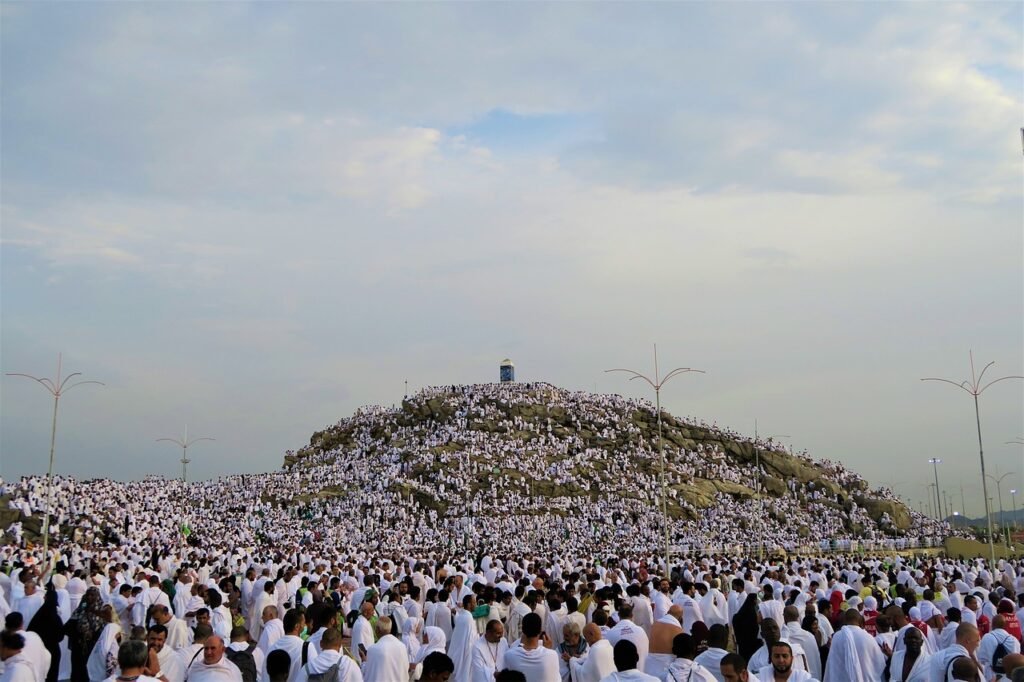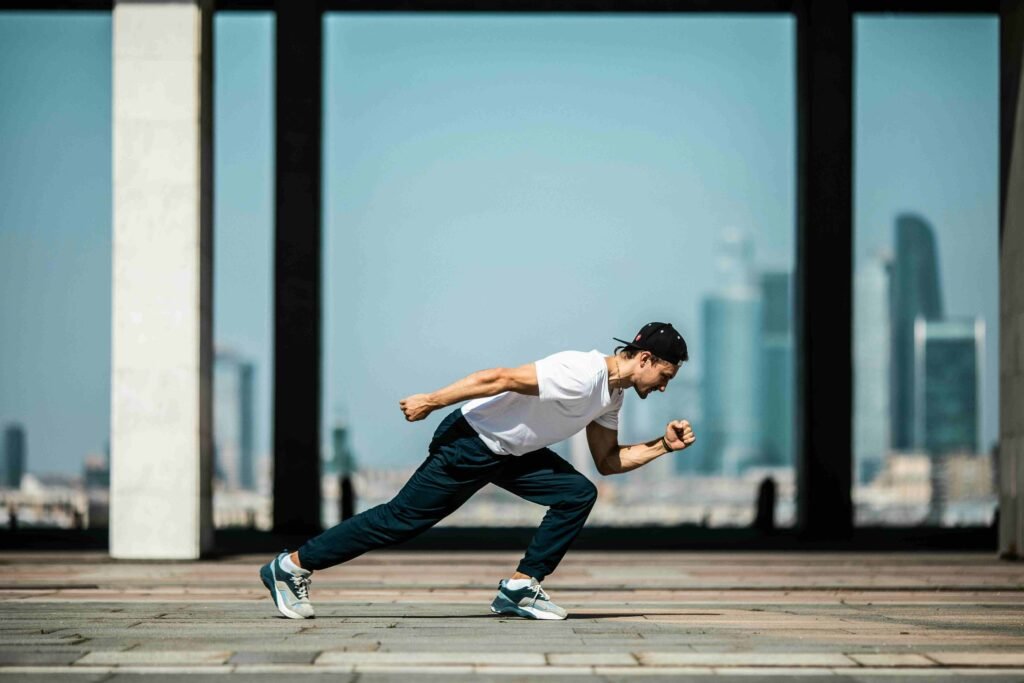- What to Do on the 9th of Dhul-Hijjah
- Significance of the 9th of Dhul-Hijjah
- Journey to Arafah and Staying in Arafah
- Prayer and Fasting in Arafah
- Supplication in the Plain of Arafah
- Being present in the Plain of Arafah
- Departing the Plain of Arafah
- Information about Arafah
- Common Mistakes and Innovations in Arafah
The 9th of Dhul-Hijjah is the main day of Hajj. On this day, the core rituals of Hajj begin, and pilgrims from around the world gather. The Prophet Muhammad (peace be upon him) said, “Al-Hajj is Arafah.” On this day, the most significant and essential pillar of Hajj, “Wuquf at Arafah,” takes place in the morning. After offering Fajr prayer on the morning of the 9th of Dhul-Hijjah, pilgrims depart for Arafah. It is recommended to perform ghusl (full-body purification) or at least wudu before heading to the plain of Arafah.
9th of Dhul-Hijjah – Day of Arafah
What to Do on the 9th of Dhul-Hijjah
After sunrise, pilgrims travel from Mina to Arafah, staying there from noon until sunset, engaging in supplications, dhikr (remembrance of Allah), and seeking forgiveness. During this time, Dhuhr and Asr prayers are performed together, shortened (qasar), and in succession. After sunset, pilgrims leave Arafah for Muzdalifah.
On the 9th of Dhul-Hijjah, it is Sunnah to depart from Mina for Arafah after performing Fajr prayer. During this time, traveling to Arafah by bus is better than walking alone or in small groups.
Significance of the 9th of Dhul-Hijjah
This day is one of the most blessed because Allah shows His mercy and forgiveness. The plain of Arafah is outside the sacred boundary of Haram. The borders of Arafah are marked with elevated markers or boards. The plain spans 10.4 kilometers and is located approximately 22 kilometers from Masjid al-Haram. In this plain, the Prophet Muhammad (peace be upon him) delivered his farewell sermon during his Farewell Hajj. The plain of Arafah is surrounded by large mountains, with a vast central flat area and some small hills.
The Prophet (peace be upon him) said in a Hadith, “Hajj is Arafah.” Aisha (may Allah be pleased with her) narrated that the Prophet (peace be upon him) said, “There is no day greater in reward than the Day of Arafah, on which Allah frees more people from Hellfire and draws closer to His servants. He boasts to the angels about them, saying, ‘What do they seek from Me?'” On this day, Iblis (Satan) feels the most humiliated and defeated as believers engage in remembrance of Allah, supplications, and seeking forgiveness, which angers and frustrates Satan greatly.
After the Fajr prayer, begin reciting Takbeer al-Tashreeq, continuing until the Asr prayer of the 13th of Dhul-Hijjah. Recite it loudly after every obligatory prayer:
Allahu Akbar, Allahu Akbar, La ilaha illa Allah
Wa Allahu Akbar, Allahu Akbar, wa lillahi al-hamd.
“Allah is the Greatest, Allah is the Greatest; there is no deity but Allah.
Allah is the Greatest, Allah is the Greatest, and all praise belongs to Allah.”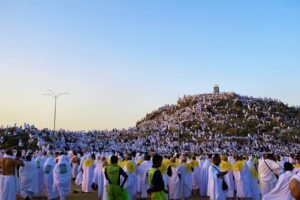
Journey to Arafah and Staying in Arafah
Due to the increasing number of pilgrims, many are taken to Arafah starting from midnight on the 9th of Dhul-Hijjah (similar to Mina). While this is against the Sunnah, it is done out of necessity, and it does not invalidate the Hajj. During such situations, Fajr prayer will not be offered in Mina without issue.
Once within the boundaries of Arafah, it is recommended to listen to the Imam’s sermon at Masjid Namirah and pray Dhuhr and Asr together during the early time of Dhuhr with one adhan and two iqamahs. If it is not possible to gather at Masjid Namirah due to the large crowds, praying in a tent within Arafah is permissible. Women may pray individually.
It is crucial to ensure that you remain within the boundaries of Arafah, as being outside these boundaries invalidates the Hajj. The markers around Arafah help in identifying its borders. Some parts of the front area of Masjid Namirah are outside Arafah’s boundaries, so staying there is not allowed. If someone mistakenly exits Arafah’s boundary, they must re-enter before sunset to fulfill the requirement of Hajj.
Within Arafah, one may stand, sit, or lie down. This stay in Arafah is known as Wuquf al-Arafah. There is no specific virtue in climbing Jabal al-Rahmah (the Mount of Mercy) in Arafah. The Prophet (peace be upon him) stood near it, but he said, “I stood here, but the whole plain of Arafah is a place of standing.”
Prayer and Fasting in Arafah
The practice is to offer Dhuhr and Asr prayers together at the beginning time of Dhuhr with one adhan and two iqamahs, shortening each prayer to two rak’ahs. No Sunnah or nafl prayers are offered before, in between, or after these two prayers. The Prophet (peace be upon him) performed them in this way with both residents and travelers. The Imam at Masjid Namirah also leads prayers this way. However, disagreements may arise in tents about how to perform these prayers. Different opinions may include performing them separately at their respective times, performing them together but without shortening, or performing them together with shortening when praying with the Imam of Masjid Namirah, while others may argue to pray them separately in tents. These views are based on fiqh rulings rather than direct evidence from Hadith or the practices of the Prophet (peace be upon him) and his companions. It is left to individual judgment to choose a method.
Fasting on the Day of Arafah
Fasting on this day expiates the sins of the previous year and the following year. However, fasting is not for pilgrims but for those who are not performing Hajj. Encourage your family members at home to fast on this day. For pilgrims, fasting on the Day of Arafah is discouraged. The Prophet (peace be upon him) did not fast on this day and drank milk or juice in front of others.
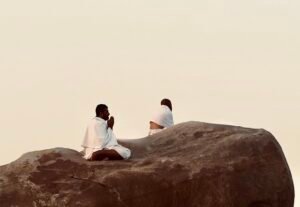
Supplication in the Plain of Arafah
When the sun begins to decline westward (after performing the Zuhr and Asr prayers as previously mentioned), you should humbly and devoutly present your supplications to Allah. The very purpose of your presence in Arafah is to make du’a (supplication) to Allah. Facing the Qiblah, raise both hands upward, keeping your armpits exposed, and pour your heart out in tears before Allah. Supplicate earnestly, seek forgiveness, and express your heartfelt desires and aspirations to Allah. Invoke Allah’s beautiful names, send blessings upon the Prophet, recite the Talbiyah, Takbeer, Dhikr, and Istighfar, and engage in du’a as much as possible. Begin by praying for yourself, then for your family and relatives, followed by your neighbors and acquaintances, and finally for the entire Muslim Ummah. Conclude your supplication with “Ameen.”
There is no requirement to make all supplications and Dhikr in Arabic; you may supplicate in your native language, such as Bangla. However, remember that it is not Sunnah to make loud or group supplications collectively. Doing so may disturb the focus of others. Supplicate privately and with humility in your heart. While making du’a, it is preferable to remain in a state of ablution, though it is not mandatory for those without wudu.
Women who are in a state of menstruation should also engage in Dhikr and supplication, just like other pilgrims. However, they must refrain from performing prayers, touching the Qur’an, or performing Tawaf around the Ka’bah. One of the best and most virtuous supplications for the Day of Arafah, as recited by the previous Prophets, is:
لَا إِلَهَ إِلَّا اللَّهُ وَحْدَهُ لَا شَرِيكَ لَهُ، لَهُ الْمُلْكُ وَلَهُ الْحَمْدُ، وَهُوَ عَلَى كُلِّ شَيْءٍ قَدِيرٌ
“La ilaha illallahu wahdahu la sharika lahu, lahul mulku walahul hamdu, wahuwa ‘ala kulli shay’in qadeer”There”
is no deity worthy of worship except Allah alone, without a partner.” To Him belongs all sovereignty and praise, and He has power over all things.”
Being present in the Plain of Arafah
The actual time for staying in Arafah begins after the sun declines westward at noon. Once you enter the boundaries of Arafah, you must remain there until sunset. Each individual must personally be present in Arafah, as proxy attendance is not permissible. Leaving Arafah before sunset requires a compensatory sacrifice (dam).
If, for any reason, someone cannot arrive in Arafah during the day but reaches after sunset and stays there until Fajr at Muzdalifah, their Hajj will still be valid. However, one must ensure to arrive before dawn; failing to do so will nullify the Hajj.
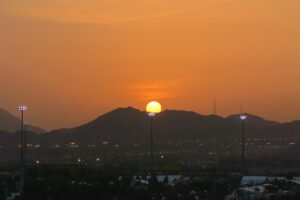
Departing the Plain of Arafah
After sunset, pilgrims must leave the Plain of Arafah peacefully and calmly, heading towards Muzdalifah without performing the Maghrib prayer at Arafah. The Maghrib prayer should be combined with the Isha prayer upon reaching Muzdalifah, as was the practice of the Prophet (peace be upon him).
Some pilgrims leave early, shortly before sunset, to avoid traffic congestion, only to cross the Arafah boundary after sunset. Such shortcuts and haste should be avoided in matters of worship. Every moment spent in Arafah is valuable and significant, so it is better to spend more time there. It is also advisable to inform your travel agency in advance to avoid early departures.
Information about Arafah
The tents in Arafat are temporary, set up for just one day. These tents are equipped with air conditioning or air coolers. While the tents are spacious, they are not as sturdy as the tents in Mina. The tents may have mattresses or carpets for the pilgrims. Surrounding the tents in Arafah, there are numerous neem trees and other plants that provide cool shade. It is commonly said that 100,000 neem saplings were gifted by Bangladesh to Saudi Arabia for planting in the Plain of Arafah.
Facilities for toilets and ablution in Arafah are very limited and insufficient. To access the toilets, one often has to wait in line for 20 to 30 minutes with 5 to 10 people ahead. Mobile phone charging facilities are also extremely limited or unavailable.
According to the promises made by the Saudi Muallim, pilgrims may receive one or two meals in Arafah. Apart from this, temporary food stalls can be found along the roadside. Additionally, food and water are distributed for free from many trucks and vehicles on the road. Pilgrims can collect these offerings, but it is advised not to push or shove, as it may result in injuries.
Transportation between Mina, Arafah, and Muzdalifah is facilitated by shuttle trains. Tickets for these trains are sold in advance. The railway platforms are always crowded with Hajj pilgrims. To access the railway platform, one must climb stairs, and the pushing and shoving can cause injuries to some.
On the morning of the day pilgrims stay in Arafah, the covering of the Ka’bah, known as the Kiswah, is replaced with a new one. This replacement occurs only once a year, always on this specific day. Pilgrims performing Tawaf of the Ka’bah after Hajj get to see the Ka’bah adorned with the new Kiswah.
Common Mistakes and Innovations in Arafah
- Staying outside the boundary of Arafah, especially in the area of Wadi Uranah.
- Leaving Arafah for Muzdalifah before sunset. Those who do this must offer a compensatory sacrifice (dam) by slaughtering an animal.
- Attempting to climb the peak of Jabal Ar-Rahmah in Arafah, rubbing hands or other body parts on the rocks, or prostrating and supplicating on the mountain.
- Raising hands towards Jabal Ar-Rahmah while making supplications.
- Touching the tall stone pillar (dome) atop Jabal Ar-Rahmah, performing prayers there, or circumambulating around the dome.
- Performing Zuhr and Asr prayers before the imam’s sermon in Masjid Namirah has concluded.
- Delaying the Asr prayer until its designated time by engaging in lengthy sermons, supplications, Dhikr, and Mawlid after the Zuhr prayer.
- Believing that the Day of Arafah coinciding with Friday is equivalent to 72 Hajj or considered a grand Hajj. There is no evidence to support this.
- Lighting fires or candles on Jabal Ar-Rahmah at sunset. Some people engage in group Mawlid, search for free food, and exchange embraces and handshakes.
- Fasting on the Day of Arafah is considered a great virtue for pilgrims, while this act is contrary to the Sunnah.
- Believing the unfounded claim that Adam and Hawa reunited in the Plain of Arafah. There is no authentic Islamic evidence or proof of this.
- Assuming that the Day of Judgment will take place in the Plain of Arafah. There is no such reference in the Quran or Hadith.

